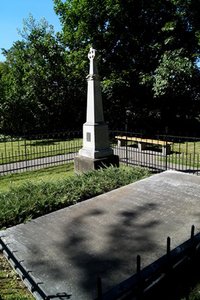Advertisement
Published: August 11th 2017

 GREAT GRAVE
GREAT GRAVE
The victims of the massacre were all buried under one slab.To the merry band of fur trappers frolicking around in the meadows of the fur rendezvous at Green River during the summer of 1836 nothing could have been more startling than the sudden appearance of two white women in creaky old wagons. Yet there they were: Narcissa Whitman and Eliza Spalding. They were stalwart missionary wives on their way to bring Jesus to the rustic natives on the Columbia Plateau. Those two were the first white women to ever cross the Blue Mountains from the east. The Spaldings set up their gospel mill on the Snake River at Lapwai, ID for the benefit of the Nez Perce. The Whitmans continued on down the river for a few more days and set up their gospel mill among the Cayuse near where the lively little community of Walla Walla would later pop up. From the beginning the Cayuse were a somewhat reluctant audience to preach at. The tall dog around those parts that Whitman had to deal with was a fellow named Chief Umtippe. The good chief was given to understand, under provisions of the original agreement with the American Board of Commissioners for Foreign Missions, that
he would be compensated for the use of the land that the mission was built on, and for the use of timber for firewood and building purposes. What Whitman understood was the land already belonged to the church. Every year Umtippe demanded payment, and every year Whitman refused to pay. The relationship was further complicated because the Cayuse were a roving people that had little, if any use whatever, for the plow, for the Bible thumping, or for the white man school (although Jim Bridger had a daughter attending Whitman’s School and so did Joe Meeks). The Bible thumping got off to a poor start due to the language barrier. The Cayuse population around the mission was always changing because the people would just wander off from time to time. The Papists had set up their own doxology works not far away and a spirited competition for the lost souls of the rustic natives soon developed. Still Whitman continued to plug away as best he could through the weary years. He genuinely tried to do his best in a difficult situation. It helped sometimes that Whitman was also a physician and could attend to certain medical needs as they arose

 WAVE JEREMY
WAVE JEREMY
It doesn't look like much of a hill, but it was steep enough to prevent me and Marcy from hiking to the top. Jeremy made it to the top though and that is him waving down to us among the Cayuse. What he could not do, however, was control the spread of white man’s infectious disease that was wreaking havoc among the rustic natives. In 1846 some Walla Wallas journeyed down to Sutter’s Fort in California to do some trading. While there they contacted measles and several of them died on the way home. The survivors sought treatment at Whitman’s and before long the infection spread to the school and a bunch of the school kids died. Before it had run its course a couple of hundred Cayuse had died of measles, and they supposed that Whitman was the cause of it. A malcontent name of Joe Lewis had taken a job at the mission and had been busily spreading the rumor that Whitman was giving poison to the people. On November 29, 1847 Tiloukaikt, Tomahas, Kiamsumpkin, Iaiachalakis, Endoklamin, and Klokomas were enraged by Joe Lewis and attacked the mission. Whitman, Narcissa and nine other whites were murdered, and 54 others, mostly school kids, were taken captive and held for ransom. A month later Peter Skene Ogden of the Hudson Bay Company arranged their release for 62 blankets, 63 cotton shirts, 12 Hudson Bay Rifles, 600 loads of ammo, and 7 pounds of tobacco. Five of the captives had already died including Helen Meeks, the daughter of Joe Meeks. There were a few more episodes of violence but that was pretty much the Cayuse War. On June 3, 1850 after a lengthy trial all of the miscreants with the exception of Endoklamin were executed by hanging down in Portland.
Advertisement
Tot: 0.084s; Tpl: 0.009s; cc: 14; qc: 28; dbt: 0.0489s; 1; m:domysql w:travelblog (10.17.0.13); sld: 1;
; mem: 1mb

 GREAT GRAVE
GREAT GRAVE
 PACKED IN LIKE SARDINES IN A CAN
PACKED IN LIKE SARDINES IN A CAN
 WAVE JEREMY
WAVE JEREMY